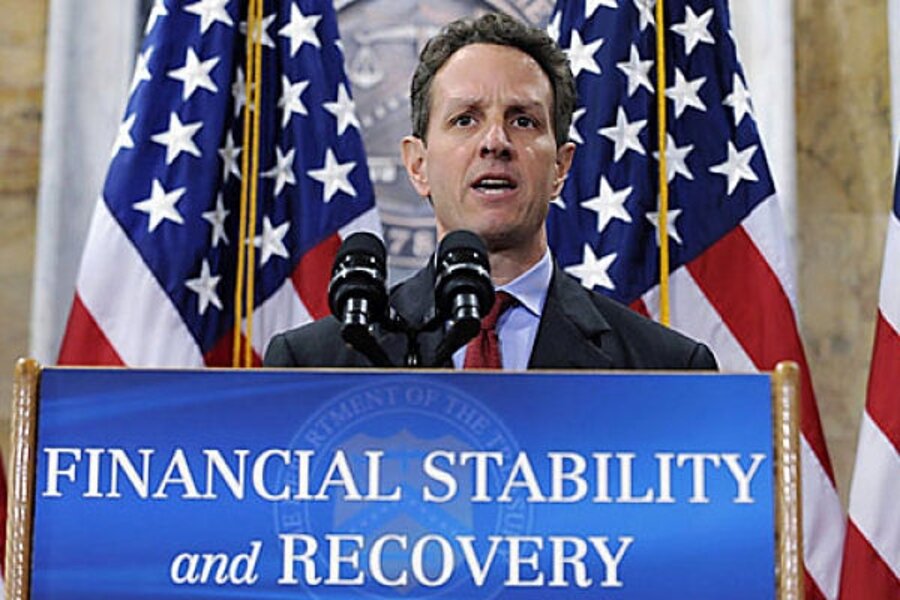Geithner's new bank bailout: Private investors hold the key
Loading...
The Obama administration’s new strategy to deal with troubled banks relies both on regulation and private-sector intervention in a bid to break a persistent credit logjam.
If the strategy, announced Tuesday by Treasury Secretary Timothy Geithner, succeeds, it would remove a major roadblock to economic recovery. If it fails, the result will be to dull the impact of President Obama’s plan to create jobs by cutting taxes and boosting government spending, many economists say.
Key elements of the Obama banking plan include:
•A review, or “stress test,” of major banks, which may expose the need for more capital if a bank is to survive. If government supplies the capital, it would come with strings attached, including the prospect that the government would take a sizable ownership stake.
•Incentives for the private sector to buy $500 billion or more of the shakiest loans or mortgage-related securities, so that they no longer raise uncertainty about the viability of banks.
•Use of at least $50 billion, of the government’s remaining $350 billion rescue fund, to prevent home foreclosures.
•Expansion of a Federal Reserve program, backed by the Treasury, to stimulate as much as $1 trillion in private-sector lending.
Whether all this can end a nearly two-year financial crisis depends on something beyond the plan’s details – how rapid and forceful the follow-through is.
“Enforceability and speed are really of the essence here,” says Carmen Reinhart, a University of Maryland economist who has studied financial crises. Any delay means that an economic rebound “keeps getting pushed further and further away.”
Secretary Geithner did not call for Congress to approve new funding, beyond the second half of a $700 billion bank rescue fund created last fall. The Obama administration is hoping to have a large impact – $1.5 trillion or more in private-sector transactions – by deploying a much smaller pool of federal dollars as a catalyst.
The idea is akin to that of a private bank leveraging $1 of capital to support $10 worth of loans. But in this case, the federal seed money is being used to patch up the banking system itself, which faces an extraordinarily large and complicated mess of soured loans.
The amount of money still apparently needed for the job prompted some raised eyebrows on Capitol Hill.
“$1.5 trillion! What a statement of how far we have come in undermining the strength of our economy over the last eight years,” said House majority leader Steny Hoyer, noting that the administration is not asking for additional federal money at this time.
Ms. Reinhart worries that the Obama team is in “denial phase,” still hoping to find a low-cost way to heal the financial system.
“It’s difficult to imagine a situation in which the private sector just jumps in and says, ‘OK, we’re going to do what the government should be doing,’ ” and buys half a trillion dollars’ worth, or more, of bad assets, she says.
Removing those assets from bank balance sheets – somehow – is crucial, so that clean banks can attract new capital and move forward with lending, economists say.
So far, infusions of capital into many of the largest banks since October appear to have calmed credit markets somewhat, but they have not removed fundamental uncertainty about the solvency of major banks.
Geithner said the new rescue plan comes with a new name, the “financial stability plan,” to replace the Bush administration’s so-called Troubled Assets Relief Program, or TARP.
He pledged to safeguard taxpayer interests. But he acknowledged the exposure that taxpayers face in such a huge rescue effort.
“This strategy will cost money. It will involve risk, and it will take time,” Geithner said Tuesday. Yet the cost to the economy of risking a financial system collapse by not acting, he said, would be “incalculable.”
He left many details to be filled in during coming weeks, and the stock market reacted by falling sharply during his speech.
Part of Geithner’s challenge may be to avoid mixed signals. He cited the risk of a gradualist approach to the crisis, yet said the administration’s comprehensive plan would inevitably evolve and adapt over time.
America’s current banking troubles are centered in the very largest institutions. Ninety to 95 percent of the nation’s 8,000 banks should be able to manage their way through the recession, say banking analysts.
The biggest banks, however, account for most of America’s banking assets. Citigroup and Bank of America, in particular, have required more than one infusion of federal assistance already.
They are considered “too big to fail,” and the Obama administration officials have said they hope to avoid nationalizing big banks.
Some finance experts, however, say some form of forceful intervention at large banks will be necessary. Banks may need to write down bad assets, receive new public capital, and see the US government get an equity stake as compensation.
Avoiding such decisive action “is never a good solution,” says Joseph Mason, a finance expert at Louisiana State University in Baton Rouge. “Forbearance is a strategy for worsening the crisis.”
The administration’s plan to spur new lending will greatly expand an existing program run by the Treasury and the Federal Reserve, called the Term Asset-Backed Securities Loan Facility. If $100 billion from the bailout fund were used, it would be enough to create an additional $1 trillion in lending, Geithner said.
The other big program, regarding banks’ bad assets, would create a partnership between the government and the private sector to get private investors to buy those assets. A key question is what kind of incentives, such as insurance against losses below a certain amount, will the US give those investors? Geithner said the program ultimately could support up to $1 trillion in purchases.
– Gail Russell Chaddock and the Associated Press contributed to this report.





